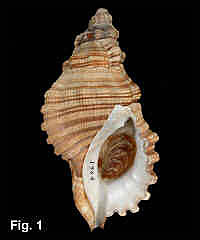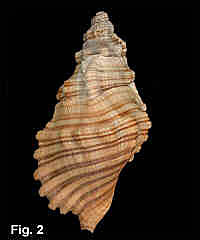

|
Cabestana
spengleri (Perry,
1811)
Description:
Shell sculptured with strong spiral ribs; shoulders strongly nodulose.
Ribs at the shoulder and below usually alternating large and small.
Shoulder nodules crossed by two large bifid ribs and a riblet between.
Outer lip thickened, strongly toothed within. Columella smooth, with one
tooth posteriorly; umbilicus nearly closed by columellar callus.
Anterior canal open, short. Rib coloration fawn, intervening grooves
brown, interior and columella white. Shell covered by a thin, smooth
yellowish-brown periostracum when alive. Operculum oval.
Size:
Up to 180 mm, commonly 80 mm, in length.
Distribution:
Australia and New Zealand. In Australia, from Caloundra, Qld, to Albany,
WA, including Tasmania.
Habitat:
Among rocks and cunjevoi on exposed rocky shores, intertidally and down
to 80 m. Common.
Synonyms:
Cymatium spengleri procerum Iredale, 1929 was assigned to the
deep water form, which is more elongate than the intertidal form, and Triton
barthelemyi Bernardi, 1857 to the more obese Victorian form. Triton
boltenianus Adams, 1854 is a small, obese form of this species.
Remarks:
This is the most common large gastropod on rocky shores around Sydney.
It can readily be found among cunjevoi, which is its main food, at dead
low tide level, and is very common as a beach shell. Its reproduction
and early life history are described by Anderson (1959).
Figs.
1,2: Sydney (DLB1963)
|